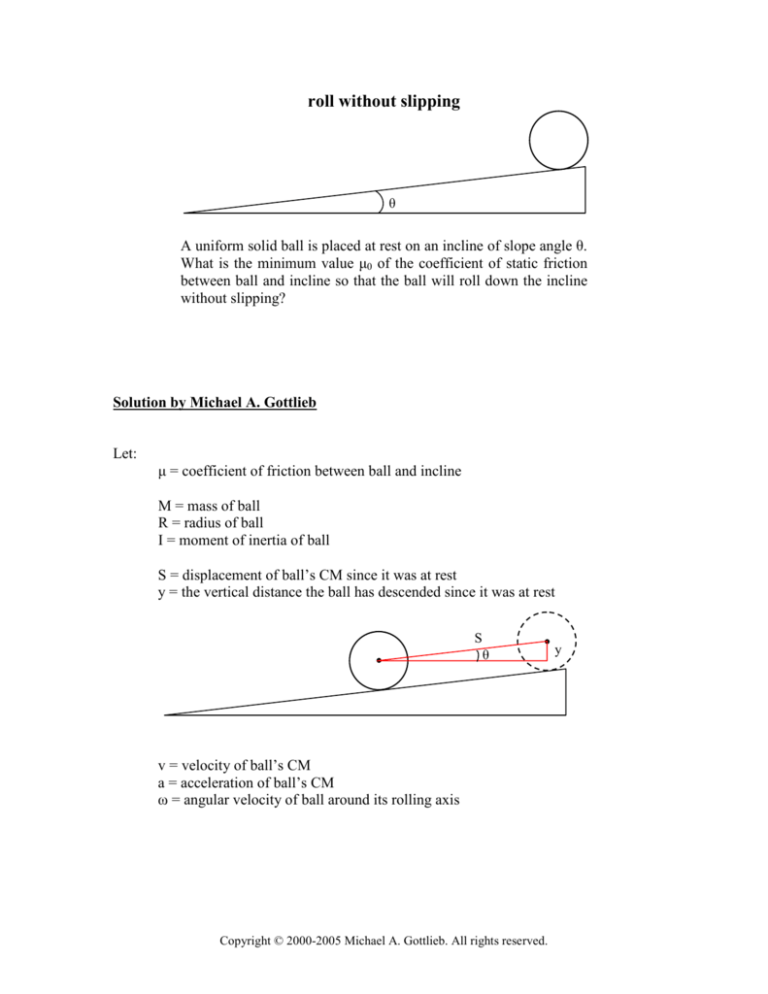
roll without slipping
θ
A uniform solid ball is placed at rest on an incline of slope angle θ.
What is the minimum value µ0 of the coefficient of static friction
between ball and incline so that the ball will roll down the incline
without slipping?
Solution by Michael A. Gottlieb
Let:
µ = coefficient of friction between ball and incline
M = mass of ball
R = radius of ball
I = moment of inertia of ball
S = displacement of ball’s CM since it was at rest
y = the vertical distance the ball has descended since it was at rest
S
θ
v = velocity of ball’s CM
a = acceleration of ball’s CM
ω = angular velocity of ball around its rolling axis
Copyright © 2000-2005 Michael A. Gottlieb. All rights reserved.
y
1. When a ball rolls without slipping and its CM has velocity v, the tangential velocity
of the ball at its radius, R, normal to the axis of rotation, must also be v, and therefore ω =
v/R.
2. The angular momentum of the ball is (by definition) Iω, and
Iω = I (v/R) = (I/R)v.
3. The total torque on the ball when it rolls without slipping is the rate of change of its
angular momentum, which equals
d ( Iω) d ( ( I R ) v )
=
= (I R ) a .
dt
dt
4. The component of the ball’s weight normal to the inclined plane is Mg cos θ . Thus,
the frictional force on the ball is µMg cos θ .
5. The frictional force is normal to the radius of the ball’s axis of rotation (when it rolls)
and it is applied at the surface of the ball (a distance R from the axis), so friction makes a
torque on the ball equal to RµMg cos θ .
6. In order for the ball not to slip, the torque on the ball from friction can not be less than
the total torque on the ball when it rolls, and therefore Rµ 0 Mg cos θ ≥ ( I R ) a , or
µ0 ≥ k
a
,
g cos θ
with k = I/MR2.
7. The total kinetic energy of the rolling ball equals
(1/2)Mv2 + (1/2)Iω2 = (1/2)Mv2 + (1/2)(kMR2)(v/R)2
= (1/2) (k+1) Mv2.
Copyright © 2000-2005 Michael A. Gottlieb. All rights reserved.
Since energy is conserved (when the ball doesn’t slip), the ball’s total kinetic energy must
equal the change in its potential energy, Mgy. Thus (1 2 )( k + 1) Mv 2 = Mgy or
v 2 = 2gy ( k + 1) . Noting that y = Ssin θ , we have
v 2 = 2gSsin θ ( k + 1)
8. Taking the derivative with respect to time on both sides of (7), and substituting v =
dS/dt and a = dv/dt, we have
2va = 2gv sin θ ( k + 1)
or
a = g sin θ ( k + 1) .
9. Substituting (8) into (6), we have
µ0 ≥ k
g sin θ ( k + 1)
.
g cos θ
And therefore, in order for the ball to roll down the inclined plane without slipping,
µ0 ≥
k
1
tan θ =
tan θ .
k +1
1 + ( MR 2 I )
10. For a uniform ball the moment of inertia I = (2/5)MR2 and therefore
µ0 ≥
2
tan θ
7
Copyright © 2000-2005 Michael A. Gottlieb. All rights reserved.










